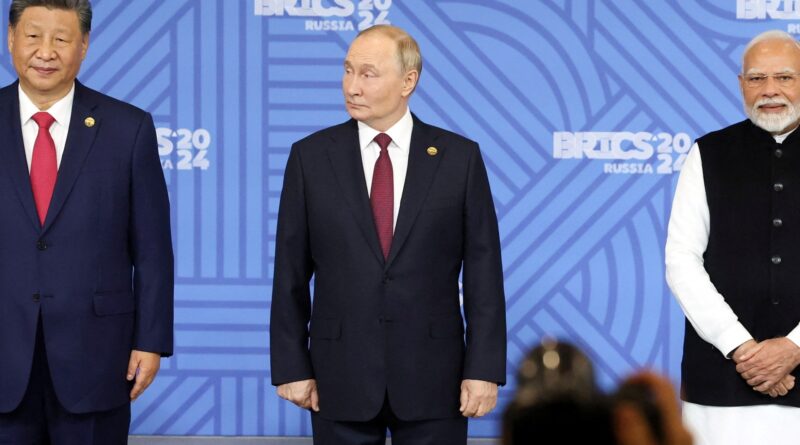Why Trump’s secondary tariffs on Russia could bite the US, its allies too
Top United States diplomatic negotiator Steve Witkoff visited Moscow on Wednesday in a last-ditch push to persuade Russian President Vladimir Putin to agree to a ceasefire with Ukraine before an August 8 deadline set by President Donald Trump.
After Witkoff’s meeting with Putin, the White House said that Russia had sought a meeting with Trump. The US president, the White House said, was open to meeting both Putin and Ukrainian President Volodymyr Zelenskyy.
Trump, who during his re-election campaign had promised he would be able to end the Russia-Ukraine war in 24 hours if he came to power, has so far failed to mediate a truce despite months of hectic diplomacy, direct talks between Moscow and Kyiv, and phone calls with Putin.
Increasingly frustrated by Putin’s unwillingness to agree to a pause in fighting without imposing conditions unacceptable to Ukraine or the West, Trump has threatened a new wave of economic measures punishing Russia if it does not accept a ceasefire.
Since Russia’s full-fledged invasion of Ukraine in February 2022, the US and its allies, including the United Kingdom and the European Union, have imposed more than 21,000 sanctions on Russia’s economy.
The new tariffs Trump has threatened are unlike any of those earlier sanctions, however. They target Russia by hitting out against its trading partners, in the hope that they will stop buying from or selling to Moscow.
But these secondary tariffs also carry risks for the US and its allies.
What are the secondary tariffs Trump is threatening?
In mid-July, as peace talks stalled despite Trump’s efforts, the US president threatened Russia with 100 percent secondary tariffs if it did not work towards a ceasefire. He gave the Kremlin a 50-day deadline to cooperate.
After Moscow suggested that it wouldn’t bow to US pressure, Trump moved up the deadline, which now expires on August 8. It is unclear if Trump’s openness to talks with Putin and Zelenskyy following Witkoff’s Moscow visit has changed that deadline.
On Wednesday, Trump doubled the tariff rate on Indian imports from 25 percent – which he had announced in late July – to 50 percent, as punishment for New Delhi’s refusal to stop buying Russian oil. That makes India the country facing the highest US tariffs at present – along with Brazil.
If Trump’s secondary tariffs go into effect, goods that the US imports from countries still trading with Russia would face duties of 100 percent on top of the tariffs Trump has already imposed on those nations.
That would at least double the price of those products, making them less competitive in the US market.
The idea behind these tariffs is to persuade Russia’s trading partners to stop buying and selling with the country, isolating its economy and depriving it of revenue it earns from exports, especially from energy.
Despite the sanctions it already faces, Russia has consistently earned more than 500 million euros ($580m) a day from energy exports since 2022. That will be disrupted if countries stop buying all oil and gas from Russia.
Which countries could Trump’s secondary tariffs hit?
The countries most affected by such secondary tariffs would be:
- China: Russia’s most important ally, China is by far the largest consumer of its northern neighbour’s exports. In 2023, China bought almost a third of all Russian exports. It also bought almost half of Russia’s oil exports.
- India: An old friend, India has been buying up large volumes of Russian crude since 2022, including almost 40 percent of Russia’s total oil exports in 2023. That year, 17 percent of Russia’s overall exports went to India. Trump had already imposed a 25 percent tariff on Indian goods. On Wednesday, he doubled that rate as punishment for India’s continued oil purchases from Russia.
- Turkey: The third-largest buyer of Russian energy, 8 percent of Russia’s exports in 2023 went to Turkiye. It is a NATO ally of the US.
Turkiye isn’t the only ally that could be hit if Trump truly targets all those who trade with Russia.
Could US allies be hit?
Pushing back against Western threats over its ties with Russia, India has pointed to the EU’s own trade with Moscow. And while that trade has plummeted since 2022, it is still substantial.
According to the EU, its total trade with Russia was worth 67.5 billion euros ($77.9bn) in 2024. India’s total trade with Russia in 2024-25, by contrast, was worth $68.7bn.
The bloc still relies heavily on Russia for its liquefied natural gas (LNG) supplies. In fact, its import of Russian LNG has been rising: In 2024, EU imports of Russian LNG were 9 percent higher than the year before.
Europe has already been hit with a 15 percent tariff from Trump. Will Trump punish his closest supporters to pressure Russia to end the war?
Could the US face risks, too?
It is not just allies – secondary tariffs on those who trade with Russia carry risks for the US itself, too.
Trump’s team is currently working on a trade deal with China, and those talks have led to a pause in a tariff war between the world’s two largest economies.
That detente would break down if Trump imposes 100 percent tariffs on Chinese goods simply because Beijing also trades with Russia.
China, Europe and India are all major suppliers of goods to the US: If the cost of those products – from clothes to lamps to iPhones – doubles, American consumers will feel the pinch.
The US also buys chemicals, including uranium hexafluoride – used in uranium enrichment – from Russia.
Will India and China stop buying Russian energy?
That looks unlikely. China continues to buy oil from Iran, despite US sanctions – and Russia is arguably its closest strategic partner.
India has also shown no sign of loosening its ties with Russia. Witkoff isn’t the only foreign envoy visiting Moscow at the moment. India’s national security adviser, Ajit Doval, is also in the Russian capital. India’s foreign minister, S Jaishankar, is expected to visit Russia later this month, and India has announced that it intends to host Putin later this year.
On Wednesday, India described Trump’s 50 percent tariff as “unfair, unjustified and unreasonable”, adding that its purchase of Russian oil was rooted in its desire for energy security for its 1.4 billion people.




